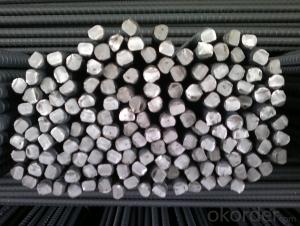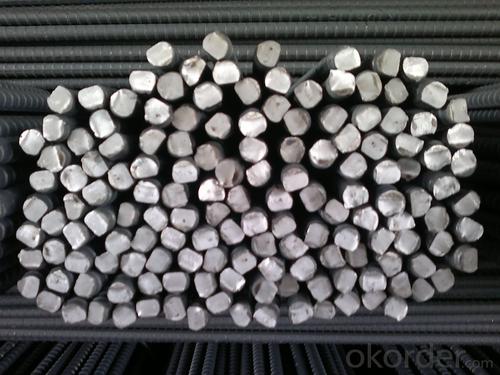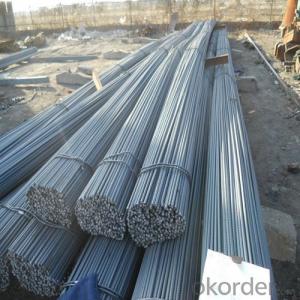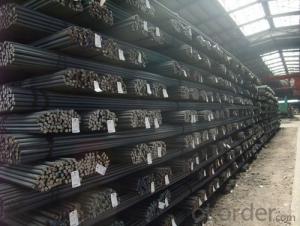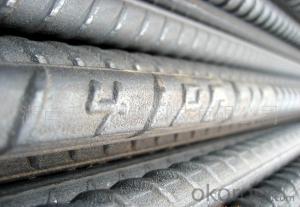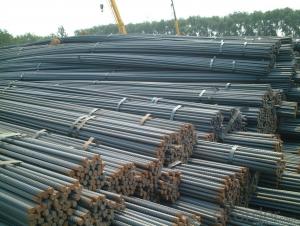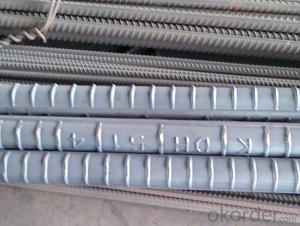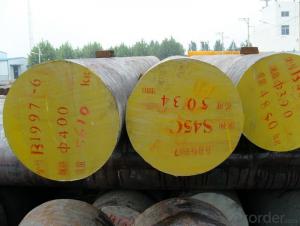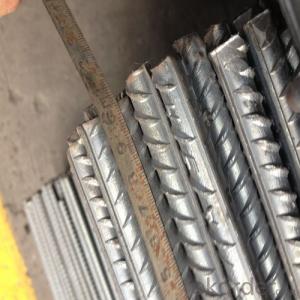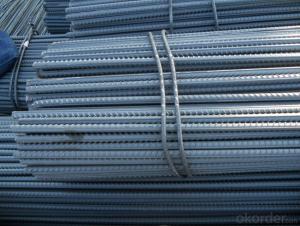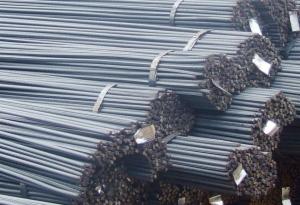Deformed steel bar HPB400;HPB500
- Loading Port:
- Tianjin
- Payment Terms:
- TT OR LC
- Min Order Qty:
- 1000 m.t.
- Supply Capability:
- 10000 m.t./month
OKorder Service Pledge
OKorder Financial Service
You Might Also Like
Product Description:
Specifications of Deformed Steel Bar:
Standard | GB | HRB335, HRB400, HRB500 | |
UK | G460B, B500A, B500B,B500C | ||
USA | GR40, GR60 | ||
Diameter | 6mm,8mm,10mm,12mm,14mm,16mm,18mm,20mm, 22mm,25mm,28mm,32mm,36mm,40mm,50mm | ||
Length | 6M, 9M,12M or as required | ||
Place of origin | Hebei, China mainland | ||
Application | building,construction,road,bridge etc | ||
Brand name | DRAGON | ||
Theoretical weight and section area of each diameter as below for your information:
Diameter(mm) | Section area (mm²) | Mass(kg/m) |
6 | 28.27 | 0.222 |
8 | 50.27 | 0.395 |
10 | 78.54 | 0.617 |
12 | 113.1 | 0.888 |
14 | 153.9 | 1.21 |
16 | 201.1 | 1.58 |
18 | 254.5 | 2.00 |
20 | 314.2 | 2.47 |
22 | 380.1 | 2.98 |
25 | 490.9 | 3.85 |
28 | 615.8 | 4.83 |
32 | 804.2 | 6.31 |
36 | 1018 | 7.99 |
40 | 1257 | 9.87 |
50 | 1964 | 15.42 |
Usage and Applications of Deformed Steel Bar:
Deformed bar is widely used in buildings, bridges, roads and other engineering construction. Big to highways, railways, bridges, culverts, tunnels, public facilities such as flood control, dam, small to housing construction, beam, column, wall and the foundation of the plate, deformed bar is an integral structure material. With the development of world economy and the vigorous development of infrastructure construction, real estate, the demand for deformed bar will be larger and larger..
Packaging & Delivery of Deformed Steel Bar:
Packaging Detail: products are packed in bundle and then shipped by container or bulk vessel, deformed bar is usually naked strapping delivery, when storing, please pay attention to moisture proof. The performance of rust will produce adverse effect.
Each bundle weight: 2-3MT, or as required
Payment term: TT or L/C
Delivery Detail: within 45 days after received advanced payment or LC.
Label: to be specified by customer, generally, each bundle has 1-2 labels
Trade terms: FOB, CFR, CIF
- Q: What are the common defects or issues associated with steel rebars?
- Common defects or issues associated with steel rebars include: 1. Rust: Steel rebars are prone to rusting when exposed to moisture or corrosive substances. Rust weakens the rebars, reducing their load-bearing capacity and compromising the structural integrity of the reinforced concrete. 2. Poor bonding with concrete: If the rebars are not properly cleaned or have a layer of rust, they may not bond well with the concrete. This can result in reduced strength and durability of the reinforced concrete structure. 3. Improper size or shape: Rebars that are incorrectly sized or shaped can lead to structural issues. For example, rebars that are too short or have inadequate coverage may not provide sufficient reinforcement, making the structure vulnerable to cracking or collapse. 4. Improper placement: Incorrect placement of rebars can lead to weak points in the reinforced concrete. This can occur if rebars are not adequately spaced, not aligned properly, or if there are gaps between the rebar and the concrete. 5. Improper storage and handling: Rebars should be stored in a dry and well-ventilated area to prevent rust. Improper storage or handling can result in surface damage, bending, or twisting of the rebars, affecting their performance in the reinforced concrete. 6. Welding defects: Welded rebars may have defects such as improper fusion, cracks, or lack of penetration, which can compromise the strength and integrity of the reinforcement. 7. Overlapping issues: Overlapping rebars is a common practice to ensure continuity in reinforcement. However, improper overlapping, such as insufficient overlap length or inadequate lapping of rebars, can result in weak joints and reduced structural strength. 8. Quality control issues: Inadequate quality control during the manufacturing or installation process can lead to defects or issues in rebars. This can include issues like improper chemical composition, inadequate strength, or deviations from the specified standards. It is crucial to address and rectify these defects or issues during the design, manufacturing, and construction stages to ensure the safe and reliable performance of reinforced concrete structures. Regular inspection, maintenance, and adherence to industry standards and guidelines are essential to mitigate these common issues associated with steel rebars.
- Q: Are there any standards or codes for steel rebars?
- Yes, there are indeed standards and codes for steel rebars. These standards and codes are essential to ensure the quality, safety, and compatibility of steel rebars used in various construction projects. One of the most widely recognized standards for steel rebars is the ASTM A615/A615M - Standard Specification for Deformed and Plain Carbon-Steel Bars for Concrete Reinforcement. This standard provides specific requirements for the physical and mechanical properties of steel rebars, such as chemical composition, yield strength, tensile strength, elongation, and bendability. It also includes guidelines for marking, packaging, and testing of rebars. In addition to ASTM A615/A615M, there are other relevant standards and codes used in different countries and regions. For example, in Europe, the European Standard EN 10080 - Steel for the Reinforcement of Concrete provides specifications for steel rebars, including dimensions, tolerances, and mechanical properties. Similarly, the British Standard BS 4449 - Steel for the Reinforcement of Concrete is widely used in the United Kingdom. These standards and codes not only ensure consistency in the manufacturing and production of steel rebars but also help architects, engineers, and construction professionals select the appropriate rebars for their projects. Compliance with these standards is crucial to guarantee the structural integrity, durability, and safety of reinforced concrete structures. It is important for stakeholders in the construction industry to be familiar with the relevant standards and codes for steel rebars and to consistently adhere to them. This helps to maintain high-quality construction practices and prevent potential failures or accidents due to substandard materials.
- Q: What is the effect of carbon content on the strength of steel rebars?
- The strength of steel rebars is significantly affected by their carbon content. Generally, a higher carbon content results in increased strength and hardness in the steel rebars. This occurs because carbon atoms create strong chemical bonds with iron atoms in the steel matrix, resulting in a more rigid and durable material. When carbon is added to the steel, it forms carbides, which are crystalline compounds that enhance the hardness and strength of the steel. The presence of these carbides improves the steel rebars' resistance to deformation, making them suitable for applications that require high strength, such as construction and infrastructure projects. Nevertheless, it is important to consider that there is a limit to how much carbon can be added to the steel rebars to enhance their strength. Excessive carbon content can make the steel brittle and prone to cracking when subjected to stress. This is because excessive carbon atoms can form large clusters of carbides, weakening the overall structure of the steel rebars. Therefore, it is crucial to carefully balance the carbon content in steel rebars to achieve the desired strength and toughness. Depending on the specific application and requirements, different levels of carbon can be utilized to optimize the strength and performance of the steel rebars. In conclusion, the carbon content directly affects the strength of steel rebars. Increasing the carbon content can enhance their strength and hardness, but excessive levels of carbon can result in brittleness. Hence, finding the appropriate balance of carbon content is essential to ensure the optimal strength and performance of steel rebars in various construction applications.
- Q: What are the different types of surface finishes available for steel rebars?
- Some of the different types of surface finishes available for steel rebars include black or plain, epoxy-coated, galvanized, and stainless steel.
- Q: What are the different types of splices used for steel rebars?
- There are several types of splices used for steel rebars, including lap splices, mechanical splices, and welded splices. Lap splices involve overlapping two rebars and tying them together with wire or other connectors. Mechanical splices use couplers or threaded sleeves to join rebars together without overlapping. Welded splices involve welding the ends of two rebars together to create a strong connection. Each type of splice has its own advantages and may be used depending on factors such as the project requirements, rebar size, and construction methods.
- Q: Can steel rebars be used in high-rise construction projects?
- Yes, steel rebars can definitely be used in high-rise construction projects. In fact, they are widely used in the construction industry for their strength and durability. Steel rebars are typically used in reinforced concrete structures, including high-rise buildings, to provide tensile strength and reinforce the concrete against cracking or failure. The use of steel rebars in high-rise construction projects helps to ensure the structural integrity and stability of the building. Additionally, steel rebars allow for flexibility in design and can be easily customized to meet the specific requirements of each project. Overall, steel rebars are an essential component in high-rise construction and play a crucial role in ensuring the safety and longevity of these structures.
- Q: Do steel rebars have any impact on the fire resistance of a structure?
- Yes, steel rebars have a significant impact on the fire resistance of a structure. The use of steel rebars in reinforced concrete provides additional strength and stability to the structure, especially during a fire. Due to their high melting point and heat transfer resistance, steel rebars help to maintain the structural integrity of the building for a longer period of time, allowing occupants to evacuate safely and giving firefighters more time to control the fire.
- Q: How do steel rebars contribute to the overall structural performance of a building?
- Steel rebars play a crucial role in enhancing the overall structural performance of a building. These reinforced steel bars are primarily used in concrete construction and provide strength and stability to the structure. Firstly, rebars reinforce the concrete by increasing its tensile strength. Concrete is highly resistant to compression forces, but it is weak when it comes to tension. By adding steel rebars, which have excellent tensile strength, to the concrete, the resulting composite material becomes much stronger and more resistant to bending or cracking under pressure. Moreover, rebars improve the durability and longevity of the building. Concrete structures are subjected to various forces such as wind, earthquakes, and heavy loads. Steel rebars act as a reinforcement network, distributing these forces throughout the concrete and preventing localized damage. This reinforcement helps to minimize the risk of structural failure, ensuring the building can withstand the test of time and environmental conditions. In addition, rebars contribute to the overall stability of the structure. By reinforcing concrete columns, beams, and slabs, rebars enhance their load-bearing capacity. This enables the building to support heavier loads without excessive deflection or collapse. The increased stability provided by the rebars also allows for more flexible and creative architectural designs, as they provide the necessary structural support for complex and unique building shapes. Furthermore, steel rebars are essential in seismic zones where earthquakes are common. The ductility and flexibility of steel allow it to absorb and dissipate the energy generated during an earthquake. This prevents the building from undergoing severe damage and helps it to retain its structural integrity, minimizing the risk to occupants. Overall, steel rebars significantly contribute to the overall structural performance of a building by enhancing its strength, durability, stability, and resistance to various forces. Their use ensures that the structure remains safe, long-lasting, and capable of withstanding the demands placed upon it, making them an indispensable component in modern construction.
- Q: What is the role of steel rebars in preventing structural failures?
- The role of steel rebars in preventing structural failures is to provide reinforcement and strength to concrete structures. By adding steel rebars to concrete, the composite material becomes more resistant to tension and bending forces. This helps to distribute and control the stress in the structure, preventing cracks and failure points from developing. The rebars also enhance the overall durability and longevity of the structure, ensuring its stability and safety over time.
- Q: Can steel rebars be used in the construction of museums and art galleries?
- Yes, steel rebars can be used in the construction of museums and art galleries. Steel rebars provide structural reinforcement and can help ensure the stability and longevity of the building. They are commonly used in the construction industry to reinforce concrete and enhance the overall strength of structures.
Send your message to us
Deformed steel bar HPB400;HPB500
- Loading Port:
- Tianjin
- Payment Terms:
- TT OR LC
- Min Order Qty:
- 1000 m.t.
- Supply Capability:
- 10000 m.t./month
OKorder Service Pledge
OKorder Financial Service
Similar products
Hot products
Hot Searches
Related keywords
